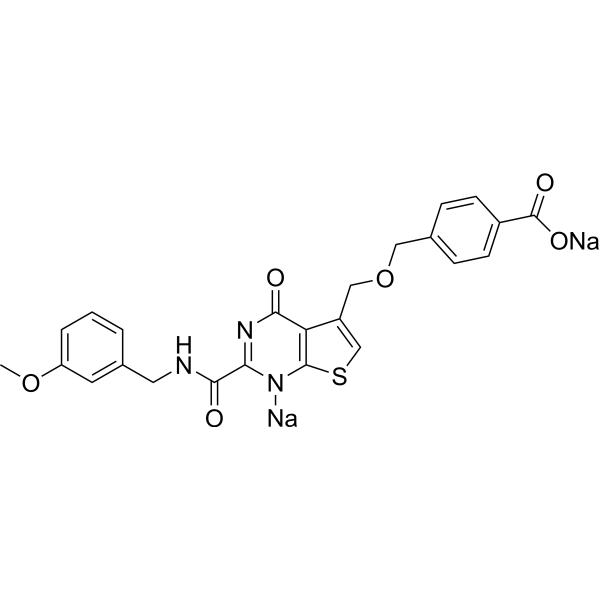- Anti-infection
- Antibody-drug Conjugate/ADC Related
- Apoptosis
- Autophagy
- Cell Cycle/DNA Damage
- Cytoskeleton
- Epigenetics
- GPCR/G Protein
- Immunology/Inflammation
- JAK/STAT Signaling
- MAPK/ERK Pathway
- Membrane Transporter/Ion Channel
- Metabolic Enzyme/Protease
- Neuronal Signaling
- NF-κB
- PI3K/Akt/mTOR
- PROTAC
- Protein Tyrosine Kinase/RTK
- Stem Cell/Wnt
- TGF-beta/Smad
- Vitamin D Related/Nuclear Receptor
- Others
Anti-infection
Apoptosis
Cell Cycle/DNA Damage
Epigenetics
GPCR/G Protein
Immunology/Inflammation
Membrane Transporter/Ion Channel
Metabolic Enzyme/Protease
- 11β-HSD
- 15-PGDH
- 17β-HSD
- 5 alpha Reductase
- Acetolactate Synthase (ALS)
- Acetyl-CoA Carboxylase
- Acyltransferase
- ADAMTS
- Adiponectin Receptor
- Aldehyde Dehydrogenase (ALDH)
- Aldose Reductase
- Aminoacyl-tRNA Synthetase
- Aminopeptidase
- Amylases
- Angiotensin-converting Enzyme (ACE)
- ANGPTL
- Apolipoprotein
- Arginase
- ATGL
- ATP Citrate Lyase
Neuronal Signaling
Protein Tyrosine Kinase/RTK
Stem Cell/Wnt
- Compound Screening Libraries
- Bioactive Screening Libraries
- •Bioactive Compound Library
- Drug Repurposing Series
- •FDA-Approved Drug Library
- •Drug Repurposing Compound Library
- Natural Products Series
- •Natural Product Library
- •Natural Product-like Compound Library
- Metabolism Series
- •Human Endogenous Metabolite Compound Library
- Disease Related Compound Libraries
- Signaling Pathway Series
- Fragment Libraries
- Diversity Compound Libraries
- •50K Diversity Library
- •5K Scaffold Library
- •3D Diverse Fragment Library
- Virtual Screening
- •50K Virtual Diversity Library
- •10M Virtual Diversity Library
- Recombinant Proteins
- Cytokines and Growth Factors
- Immune Checkpoint Proteins
- CAR-T Related Proteins
- CD Antigens
- Fc Receptors
- Receptor Proteins
- Enzymes & Regulators
- Complement System
- Ubiquitin Related Proteins
- Viral Proteins
- Biotinylated Proteins
- Fluorescent-labeled Recombinant Proteins
- GMP-grade Proteins
- Animal-free Recombinant Proteins
- Protein Expression Service
- Custom Synthesis Service
- ADC-Related Custom Services
- PROTAC-Related Custom Services
- Cytokines and Growth Factors
- Immune Checkpoint Proteins
- CAR-T Related Proteins
- CD Antigens
- Fc Receptors
- Receptor Proteins
- Enzymes & Regulators
- Complement System
- Ubiquitin Related Proteins
- Viral Proteins
- Biotinylated Proteins
- Fluorescent-labeled Recombinant Proteins
- GMP-grade Proteins
- Animal-free Recombinant Proteins
- Others
- View More
CAR-T Related Proteins
- CD27 Ligand/CD70
- CD4
- CD19
- CD27 Ligand/CD70
- CD123
- CD138/Syndecan-1
- Epithelial Cell Adhesion Molecule (EpCAM)
- Folate Receptor 1
- GPC-3
- Guanylate Cyclase 2C
- ErbB2/HER2
- ErbB3/HER3
- c-Met/HGFR
- MSLN
- CA-125
- ROR1
- CEACAM-5
- CD314/NKG2D
- Prostate Specific Membrane Antigen
- CD319/SLAMF7
- TROP-2
- Siglec-6
- Folate Receptor alpha (FR-alpha)
- CD314/NKG2D
- Siglec-3/CD33
- CD27 Ligand/CD70
- CD319/SLAMF7
- ErbB2/HER2
- Siglec-3/CD33
- CD7
- MUC-1/CD227
CD Antigens
- T Cell CD Proteins
- B Cell CD Proteins
- NK Cell CD Proteins
- Macrophage CD Proteins
- Monocyte CD Proteins
- Stem Cell CD Proteins
- Platelet CD Proteins
- Erythrocyte CD Proteins
- Dendritic Cell CD Proteins
- Epithelial cell CD Proteins
- Endothelial cell CD Proteins
- Signal Transduction-related CD Proteins
- Cell Adhesion-related CD Proteins
Receptor Proteins
- Receptor Tyrosine Kinases
- Receptor Serine/Threonine Kinases
- Receptor Tyrosine Phosphatase
- Receptor Guanylyl Cyclase Family
- Cell Adhesion Molecules (CAMs)
- G-Protein-Coupled Receptors (GPCRs)
- Nuclear Receptor Superfamily
- Pattern Recognition Receptors
- Notch family
- Siglec
- Leukocyte Immunoglobin-like Receptors
- Killer-Cell Immunoglobulin-like Receptors
- Cytokine Receptors
Enzymes & Regulators
- Oxidoreductases (EC 1)
- Transferases (EC 2)
- Hydrolases (EC 3)
- Lyases (EC 4)
- Isomerases (EC 5)
- Ligases (EC 6)
- Translocases (EC 7)
- Matrix Metalloproteinases
- ADAMs/ADAMTSs
- Cathepsin
- Carboxypeptidase
- Angiotensin-converting Enzymes
- Caspase
- Carbonic Anhydrase
- Serine/Threonine Kinase Proteins
- Protein Tyrosine Kinases
- Phosphatase
- Topoisomerase
- Protease Inhibitors
- Protein Kinase Inhibitor Peptide (PKI)
- Cyclin-Dependent Kinase Inhibitor Proteins
- Cystatin Family
- Molecular Biology
- •Nucleic Acid Gel Electrophoresis
- •Vector Construction
- •Restriction Endonuclease
- •Materials
- •PCR & qPCR
- •RT-PCR
- •Sequencing
- Protein Biology
- •Protein Sample Preparation
- •Protein Purification
- •Protein Electrophoresis & WB
- •Labeling Kit
- •Multiple Fluorescent Staining
- Cell Biology
- •Cell Culture
- •Cell Analysis
- •3D Cell Culture
- •Cell Isolation
- View More
- Custom Synthesis Service
- Bulk and Custom Synthesis Service
- ADC-Related Custom Services
- PROTAC-Related Custom Services
- Custom Reference Standard Products
- Custom Peptide Synthesis
- Protein Expression Service
- Recombinant Antibody Expression Service
- Protein Crystal Structure Elucidation
- Oligonucleotide Synthesis
- Fluorescent labeling Service
- Custom Synthesis of Stable Isotope-Labeled Compounds
- One-stop CDMO Service
- One-stop Compound Screening Platform
- Virtual Screening
- Molecular dynamics simulation
- Cell-based Compound Screening
- Ion Channel Screening
- Kinase Screening Service
- Surface Plasmon Resonance (SPR) Assay Service
- GPCR Bioassay Screening Services
- Nuclear Receptor Screening Services
- Affinity Mass Spectrometry
- DEL Synthesis and Screening
- Molecular Interaction Assay Service
- AI-Driven Drug Screening
- Molarity Calculator
- Dilution Calculator





















































































































![[Ala107]MBP(104-118)](http://file.medchemexpress.eu/product_pic/hy-p1289a.gif)
![[Ala113]MBP(104-118)](http://file.medchemexpress.eu/product_pic/hy-p1289.gif)

![[Ala113]MBP(104-118) TFA](http://file.medchemexpress.eu/product_pic/hy-p1289c.gif)
![[Ala107]MBP(104-118) TFA](http://file.medchemexpress.eu/product_pic/hy-p1289b.gif)














![[Pro3]-GIP (mouse)](http://file.medchemexpress.eu/product_pic/hy-p1434.gif)


















































































































































































![Thalidomide-2,6-diazaspiro[3.4]octane-C-piperidine-C2-O-C-boc](http://file.medchemexpress.eu/product_pic/hy-161189.gif)













































































































































































![Thalidomide-2,6-diazaspiro[3.4]octane-C-piperidine-C2-O-C2-OH](http://file.medchemexpress.eu/product_pic/hy-161197.gif)







































































































































































































































































































































































































































































![Octahydrocyclopenta[c]pyrrole](http://file.medchemexpress.eu/product_pic/hy-w125014.gif)
















































































































































































































































































![Thalidomide-2,6-diazaspiro[3.4]octane-C-piperidine-C-boc](http://file.medchemexpress.eu/product_pic/hy-161196.gif)



































































































![[Tyr22] Calcitonin Gene Related Peptide, (22-37), rat](http://file.medchemexpress.eu/product_pic/hy-p3689.gif)








































































































































































































![[1,1'-Biphenyl]-3-amine-13C6 hydrochloride](http://file.medchemexpress.eu/product_pic/hy-w106014s.gif)




































































![Thalidomide-piperidine-C-2,6-diazaspiro[3.3]heptane-C2-OH](http://file.medchemexpress.eu/product_pic/hy-161190.gif)













































































































![[C3MPr]NTf2](http://file.medchemexpress.eu/product_pic/hy-w099927.gif)






















































































































































































































































































































































































































































































































































































































































































































































































































































































































































![[Ser25] Protein Kinase C (19-31)](http://file.medchemexpress.eu/product_pic/hy-p1088.gif)



























































![[Lys4] Sarafotoxin S6c](http://file.medchemexpress.eu/product_pic/hy-p3563.gif)





























































































![Benzo[pqr]tetraphen-3-ol-13C6](http://file.medchemexpress.eu/product_pic/hy-w585890s.gif)










































































































































![2-[4-(1-Ethyl-1,4-dimethylpentyl)phenoxy]ethanol-13C6](http://file.medchemexpress.eu/product_pic/hy-w777583.gif)














































![7-Piperazin-1-yl-thieno[2,3-c] pyridine hydrochloride](http://file.medchemexpress.eu/product_pic/hy-w327038.gif)

































































































































































































![7H-Dibenzo[c,g]carbazole](http://file.medchemexpress.eu/product_pic/hy-119983.gif)






























![Dibenzo[b,d]furan-13C12](http://file.medchemexpress.eu/product_pic/hy-w017086s2.gif)















































































































![Deoxyribosyl dihydropyrimido[4,5-c][1,2]oxazin-7-one](http://file.medchemexpress.eu/product_pic/hy-154171.gif)








































































































































































































































































![5H-Benzofuro[3,2-c]carbazole-d10](http://file.medchemexpress.eu/product_pic/hy-w090625s.gif)


























































































































































































































![PIP-C-3-Azaspiro[5.5]undecane-boc](http://file.medchemexpress.eu/product_pic/hy-161656.gif)





















































































































































































































































![N-[4-(2-Pyridinyl)benzoyl]glycine-13C2,15N](http://file.medchemexpress.eu/product_pic/hy-144348s.gif)






























































































![c[Arg-Arg-Arg-Arg-Nal-Nal-Nal]](http://file.medchemexpress.eu/product_pic/hy-p3349.gif)
































![Thalidomide-NH-C2-azaspiro[3.5]nonane hydrochloride](http://file.medchemexpress.eu/product_pic/hy-153042.gif)




![c[Arg-Arg-Arg-Arg-Dip-Dip-Dip]](http://file.medchemexpress.eu/product_pic/hy-p3348.gif)








































































































































































![[Pyr1]-Apelin-13, Pro(13C5,15N) TFA](http://file.medchemexpress.eu/product_pic/hy-p1033s1.gif)




















































































![Thalidomide-2,6-diazaspiro[3.4]octane-C-Pip-boc](http://file.medchemexpress.eu/product_pic/hy-161209.gif)
















![4,5,6,7-Tetrahydrothieno[3,2-c]pyridine hydrochloride](http://file.medchemexpress.eu/product_pic/hy-21089.gif)
















![3,4,5,6-Tetrabromo[1,1′-biphenyl]-2,2′-diol-13C12](http://file.medchemexpress.eu/product_pic/hy-166939s.gif)












![Benzo[c][1,8]naphthyridin-6(5H)-one](http://file.medchemexpress.eu/product_pic/hy-115862.gif)


































































































![Thalidomide-NH-C2-2-azaspiro[3.3]heptane](http://file.medchemexpress.eu/product_pic/hy-168312.gif)



































![2-Methoxyphenyl dihydrouracil-azaspiro[5.5]undecane-C-PIP](http://file.medchemexpress.eu/product_pic/hy-161657.gif)








![NH2-c[X-R-L-S-X]-K-G-P-(D-1Nal)](http://file.medchemexpress.eu/product_pic/hy-p3346.gif)






















![Benzo[f]tetraphene](http://file.medchemexpress.eu/product_pic/hy-w011577.gif)



















































![6-(3-Nitrophenyl)-5H-dibenzo[c,e]azepine-5,7(6H)-dione](http://file.medchemexpress.eu/product_pic/hy-q51222.gif)




![2-Amino-3-methyl-3H-imidazo[4,5-f]quinoline-2-13C](http://file.medchemexpress.eu/product_pic/hy-w779193.gif)

























![NH2-c[X-R-L-S-X]-K-G-P-(D-2Nal)](http://file.medchemexpress.eu/product_pic/hy-p3347.gif)














![(S)-Deoxy-thalidomide-2,7-diazaspiro[3.5]nonane-C-Pip](http://file.medchemexpress.eu/product_pic/hy-168310.gif)




























































































































































































































![3-Benzyl-8,9-dimethoxy-5-[(2-methylbenzyl)thio]imidazo[1,2-c]quinazolin-2(3H)-one](http://file.medchemexpress.eu/product_pic/hy-q51221.gif)



































































































































































































































![4-Chloro-7-(2-β-C-methyl-β-D-ribofuranosyl)-7H-pyrrolo[2,3-d] pyrimidine](http://file.medchemexpress.eu/product_pic/hy-152818.gif)





















































































![10-(4-(Bis(2-hydroxyethyl)amino)phenyl)-5,5-difluoro-1,3,7,9-tetramethyl-5H-dipyrrolo[1,2-c:2',1'-f][1,3,2]diazaborinin-4-ium-5-uide](http://file.medchemexpress.eu/product_pic/hy-d1551.gif)










































![4-Amino-1-(2-C-methyl-β-D-ribofuranosyl)-1H-pyrrolo[2,3-d]pyrimidine-5-carbonitrile](http://file.medchemexpress.eu/product_pic/hy-152718.gif)




































































![4-Amino-5-iodo-7-(2-β-C-methyl-β-D-ribofuranosyl)-7H-pyrrolo[2,3-d]pyrimidine](http://file.medchemexpress.eu/product_pic/hy-152819.gif)














































































































































































































































































![CCR2-RA-[R]](http://file.medchemexpress.eu/product_pic/hy-50081.gif)















































































![2-Amino-6-chloro-9-[(2,3,5-tri-O-benzoyl-2-C-Methyl-beta-D-ribofuranosyl)]-9H-purine](http://file.medchemexpress.eu/product_pic/hy-w069715.gif)




![[Glp5,(Me)Phe8,Sar9] Substance P (5-11)](http://file.medchemexpress.eu/product_pic/hy-p3801.gif)















































































































![6-(2-O-Methyl-beta-D-ribofuranosyl)-3-(2-oxo-propyl)-6H-imidazo[1,2-c]pyrimidin-5-one](http://file.medchemexpress.eu/product_pic/hy-152770.gif)

















































































































































































































































































































































































![(1S,3aR,6aS)-(2S)-2-Cyclohexyl-N-(2-pyrazinylcarbonyl)glycyl-3-methyl-L-valyl-N-[(1R)-1-[2-(cyclopropylamino)-2-oxoacetyl]butyl]octahydrocyclopenta[c]pyrrole-1-carboxamide-d4](http://file.medchemexpress.eu/product_pic/hy-a0052s.gif)

























































































































































































































































































































































































































































































![[Ala9,10, Lys11,12] Glycogen Synthase (1-12)](http://file.medchemexpress.eu/product_pic/hy-p3741.gif)




































![β-D-glucopyranosyl-[α-L-rhamnopyranosyl-(1→3)-βD-glucuronopyranosyl-(1→3)]-3β-hydroxyolean-12-ene28-oate](http://file.medchemexpress.eu/product_pic/hy-n9522.gif)




































































































































































































































































































































































![1,1′-Ethylidenebis[L-tryptophan]](http://file.medchemexpress.eu/product_pic/hy-w585843.gif)









































































































































































































































































































































































































































































































































































































































































































































































































































































































































































































































































![[Sar4] Substance P (4-11)](http://file.medchemexpress.eu/product_pic/hy-p3932.gif)








































































































































































































































































































































































































































































































































































































































































































































































































































































































































































































































































































































![5-[(2-Nitrophenyl)methylene]-2,4-thiazolidinedione](http://file.medchemexpress.eu/product_pic/hy-131044.gif)




































![([D8]Val7,10)-C-Peptide (human)](http://file.medchemexpress.eu/product_pic/hy-p4229.gif)



